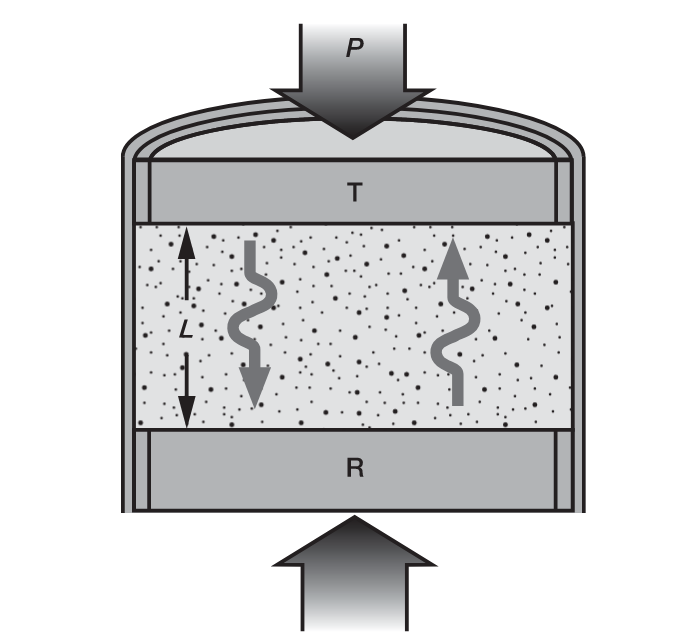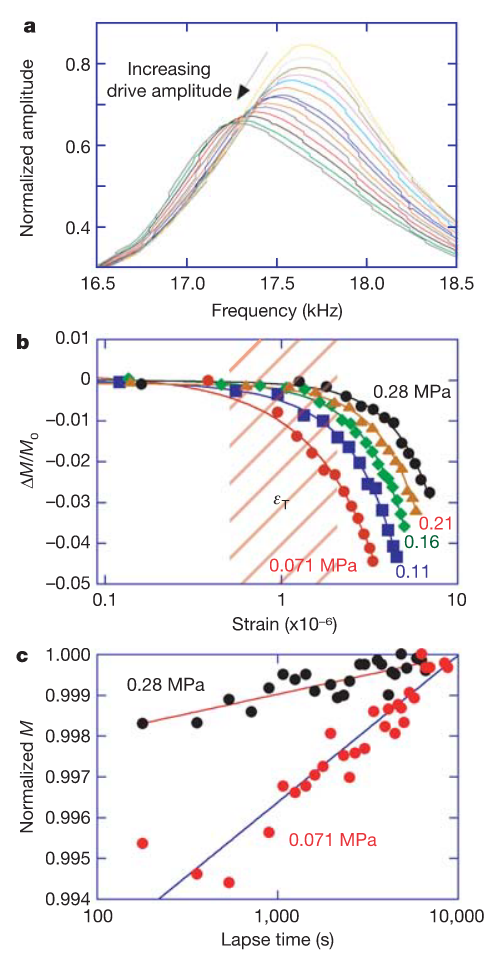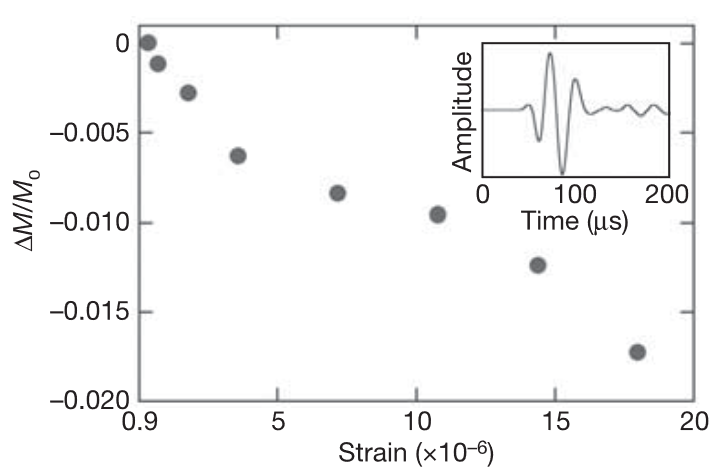Introduction
The 1992 magnitude 7.3 Landers earthquake triggered an exceptional number of additional earthquakes within California and as far north as Yellowstone and Montana. Since this observation, other large earthquakes have been shown to induce dynamic triggering at remote distances—for example, after the 1999 mag- nitude 7.1 Hector Mine and the 2002 magnitude 7.9 Denali earthquakes—and in the near-field as aftershocks.
1992 年发生的 7.3 级 Landers 地震引发了 California 境内以及远至北部 Yellowstone 公园和 Montana 州的大量地震。自此以后,其他大地震也被证明会在远距离引发动力学诱导–例如,1999 年 7.1 级 Hector 矿山地震和 2002 年 7.9 级 Denali 地震之后,以及在近场作为余震引发的地震。
The physical origin of dynamic triggering, however, remains one of the least understood aspects of earthquake nucleation. The dynamic strain amplitudes from a large earthquake are exceedingly small once the waves have propagated more than several fault radii. For example, a strain wave amplitude of $10^{-6}$ and wavelength 1 m corresponds to a displacement amplitude of about $10^{-7} \text{ m}$.
然而,动力学触发的物理起源仍然是人们对地震成核了解最少的方面之一。一旦应变波传播超过几个断层半径,大地震产生的动态应变振幅就会非常小。例如,应变波振幅为 $10^{-6}$ ,波长为 $1\text{ m}$,对应的位移振幅约为 $10^{-7}\text{ m}$。
Here we show that the dynamic, elastic-nonlinear behaviour of fault gouge perturbed by a seismic wave may trigger earthquakes, even with such small strains. We base our hypothesis on recent laboratory dynamic experiments conducted in granular media, a fault gouge surrogate. From these we infer that, if the fault is weak, seismic waves cause the fault core modulus to decrease abruptly and weaken further. If the fault is already near failure, this process could therefore induce fault slip.
在这里,我们展示了受到地震波扰动的断层破碎带的动态弹性非线性行为,即使应变很小,也可能引发地震。我们的假设基于最近在颗粒介质(断层破碎带的替代物)中进行的实验室动态实验。由此我们推断,如果断层很脆弱,地震波会导致断层核心模量突然降低,并进一步减弱。如果断层已经接近破坏,这一过程就会引起断层滑动。
Several dynamic triggering mechanisms have been proposed, based primarily on fluid-mechanical interaction in the fault gouge (rock that has been highly fractured and ‘worked’ by the adjacent crustal blocks into a granular state), because remote triggering appears more commonly in geothermal areas. Proposed mechanisms include increased pore pressure associated with the following: the compaction of saturated fault gouge (liquefaction), leading to failure; cyclic fatigue of gouge from the oscillatory wave; and a ‘sub-critical crack growth’ mechanism in which, at crack tips in wet rocks, chemical reactions are accelerated by the wave stresses, leading to failure.
提出了几种动态触发机制,主要基于断层破碎带(已被邻近地壳块体高度断裂并 “加工” 成颗粒状的岩石)中的流体-机械相互作用,因为远程触发在地热区更为常见。提出的机制包括与下列因素有关的孔隙压力增加:饱和断层破碎带的压实(液化),导致破坏;振荡波对断层破碎带产生的周期性疲劳;以及 “亚临界裂缝生长” 机制,即在潮湿岩石的裂缝尖端,化学反应被波应力加速,导致破坏。
It was reported recently that co-seismic release of $\text{CO}_{2}$ overpressure from a deep source (presumably rare) was responsible for the triggering of activity related to two large events in northern Italy. It has also been shown that triggering takes place in regions not associated with geothermal activity. Thus, one or more mechanisms must exist that can explain triggering in dry or both wet and dry conditions. In short, there is much speculation about the mechanism, but experimental and field validation is lacking.
最近有报告称,在意大利北部发生的两起大事件中,与地震有关的来自深层源头的 $\text{CO}_{2}$ 超压释放(可能极为罕见)是引发活动的原因。研究还表明,在与地热活动无关的地区也会发生触发事件。因此,必须有一种或多种机制可以解释在干燥或 “既湿又干燥” 条件下的触发。总之,人们对这一机制有很多猜测,但缺乏实验和实地验证。
We suspect that dynamic elastic nonlinearity of fault gouge might have a function in triggering because we have observed temporary decrease in modulus (material softening) in the laboratory in a variety of rock types under the influence of wave excitation at seismic strains ($10^{-6}$ to $10^{-4}$) (ref. 20).
Bearing this in mind, we set out to study material softening in granular media in the laboratory, and to understand its relationship to material weakening, a necessary ingredient in dynamic triggering. A schematic diagram of the experimental setup is shown in Fig. 1. The granular medium is composed of glass beads of diameter $d = 0.6–0.8\text{ mm}$, poured into a duralumin cylinder of diameter $D =30\text{ mm}$ and filled to a height of $L = 18.5\text{ mm}$.
我们怀疑断层破碎带的动态弹性非线性可能在触发过程中起作用,因为我们在实验室中观察到,在地震应变($10^{-6}$ 至 $10^{-4}$)的波激励作用下,各种类型岩石的模量会暂时降低(材料软化)(参考文献 20)。
有鉴于此,我们开始在实验室研究颗粒介质中的材料软化,并了解其与材料劣化之间的关系,材料劣化是动态触发的必要因素。实验装置示意图如图 1 所示。颗粒介质由直径为 $d = 0.6-0.8\text{ mm}$ 的玻璃珠组成,倒入直径为 $D = 30\text{ mm}$ 的硬铝圆柱体中,填充高度为 $L = 18.5\text{ mm}$。

Diagram of the set-up for conducting resonance and pulse-mode experiments in the glass bead pack under applied pressure $P$. T and R denote the piezoelectric transmitter and the receiver, respectively, and $L$ is the sample thickness.
在施加压力 $P$ 的玻璃珠堆积中进行共振和脉冲模式实验的装置示意图。T 和 R 分别表示压电发射器和接收器,$L$ 是样品厚度。
The container is closed with two fitted pistons (piezo-electric transducers) and a normal load corresponding to effective pressure $P$ (effective pressure = confining pressure minus pore pressure, and the pore pressure is 1 atm (0.101 MPa)) ranging from 0.07 to 0.3 MPa is applied to the granular sample across the top piston. Before the acoustic measurements, ten cycles of loading and unloading are performed to consolidate the sample. The volume fraction of glass beads thus obtained is found to be $0.63 \pm 0.01$. The bead packing is then held under stress for $12\text{ h}$ so that the healing process of asperity contact between the grains, known as ‘aging’, comes to equilibrium.
容器用两个合适的活塞(压电传感器)封闭,在顶部活塞上对颗粒样品施加与有效压力 $P$(有效压力 = 封闭压力-孔隙压力,孔隙压力为 1 atm (0.101 MPa))相对应的 0.07 至 0.3 MPa 的法向载荷。在进行声学测量之前,先进行十次加载和卸载循环,以巩固样品。结果发现玻璃珠的体积分数为 $0.63 \pm 0.01$。然后将玻璃珠堆积在应力作用下保持 $12$ 小时,这样晶粒之间的晶面接触愈合过程(称为 “老化”)就达到了平衡。
In the Earth, the fault core may be impacted by all conceivable wave types. Here we limit our studies to compressional $P$ waves (actually Young-mode waves) to discern whether the general effect of modulus reduction takes place. Wave velocities in the glass bead pack were measured with the application of resonance and travelling wave methods.
Because of self-amplification, resonance provides the most sensitive means by which to interrogate elastic nonlinear behaviour quantitatively (see Methods). Figure 2a shows resonance curves in the glass bead pack under 0.11 MPa effective pressure. The graph shows a plot of detected amplitude against frequency at progressively increasing input voltages, normalized by the input voltage.
在地球上,断层核心可能受到所有可以想象到的波的影响。在这里,我们的研究仅限于压缩 $P$ 波(实际上是杨氏模量波),以确定模量降低是否会产生普遍影响。我们采用共振法和行波法测量了玻璃珠堆积中的波速。
由于共振具有自放大作用,因此共振是定量分析弹性非线性行为的最灵敏的方法(见方法)。图 2a 显示了玻璃珠堆积在 $0.11$ 兆帕有效压力下的共振曲线。图中显示的是在输入电压逐渐增大的情况下,检测到的振幅与频率的关系图,并按输入电压进行了归一化处理。

Material softening due to nonlinear dynamics under resonance conditions. a, Resonance curves of the fundamental $P$-wave mode with increasing input amplitude measured at the detector R (see Methods). b, The change in normalized modulus $\Delta M/M_{0} = (M- M_{0})/M_{0}$ with detected strain at five effective pressures as noted. $M$ is the modulus as a function of amplitude, and $M_{0}$ is the low-amplitude (linear) modulus. c, Slow dynamics recovery of the modulus under two different effective pressures, showing the recovery of the modulus with lapse time. The modulus is normalized to its rest, equilibrium value.
共振条件下非线性动力学引起的材料软化. a, 在探测器 R 处测量到的基本 $P$ 波模式随输入振幅增加而产生的共振曲线(见 Methods)。 b, 在五种有效压力下,归一化模量 $\Delta M/M_{0} = (M- M_{0})/M_{0}$ 随检测到的应变而发生的变化。$M$ 是模量, 为振幅的函数,$M_{0}$ 是低振幅(线性)模量。 c,两种不同有效压力下模量的慢动态恢复,显示模量随时间推移的恢复情况。模量以其静态平衡值进行归一化。
As input voltage is increased, the resonance frequency $f_{r}$ decreases, corresponding to a decrease in velocity and modulus. The resonance peak broadening and amplitude decrease is an indication of significant, simultaneous nonlinear dissipation.
The change in $f_{r}$ of about $2.6\%$ corresponds to a decrease in Young modulus of about $5.2\%$ over a strain amplitude range of $10^{-7}$ to $5 \times 10^{-6}$. For comparison, strains measured from seismic waves at hundreds of kilometres from a moderate sized earthquake are of order $10^{-7}$ to $10^{-6}$, depending on the distance travelled and the source radiation pattern.
随着输入电压的增加,共振频率 $f_{r}$ 会降低,这与速度和模量的降低相对应。共振峰变宽和振幅减小表明同时存在大量非线性耗散。
在 $10^{-7}$ 到 $5 \times 10^{-6}$ 的应变振幅范围内,约 $2.6\%$ 的 $f_{r}$ 变化对应于约 $5.2\%$ 的杨氏模量下降。相比之下,在距离中等规模地震数百公里处通过地震波测得的应变大约在 $10^{-7}$ 到 $10^{-6}$ 之间,具体取决于传播距离和震源辐射模式。
To explore the influence of effective pressure on the nonlinear response, our experimental procedure is repeated at five progressively increasing pressures, as shown in Fig. 2b. Modulus softening diminishes progressively as the pressure is increased, meaning that the system elastic nonlinearity decreases with increasing pressure.
The decrease in normalized modulus change $\Delta M/M_{0}$ (~$2\Delta f/f_{r} = 2\Delta V/V_{0}$, where $M_{0}$ is the linear, equilibrium modulus) ranges from about $4.8\%$ to $3\%$ between $0.071$ and $0.28\text{ MPa}$ effective pressure, respectively, for strains ranging from $10^{-7}$ to $7\times 10^{-6}$. Thus, in the fault core, we may expect the same behaviour if the fault is weak and/or the effective pressure is low.
为了探索有效压力对非线性响应的影响,我们在五个逐渐增大的压力下重复实验过程,如图 2b 所示。随着压力的增加,模量软化逐渐减小,这意味着系统的弹性非线性随着压力的增加而减小。
归一化模量变化 $\Delta M/M_{0}$ (~$2\Delta f/f_{r} = 2\Delta V/V_{0}$,其中 $M_{0}$ 是线性平衡模量)的下降幅度从约 $4.8%$ 到 $3%$,有效压力分别介于 $0.071$ 和 $0.28\text{ MPa}$ 之间,应变范围为 $10^{-7}$ 到 $7\times 10^{-6}$。因此,在断层核心区,如果断层较弱和/或有效压力较低,我们可以预期会出现相同的行为。
There is evidence that the effective pressure in some fault cores can be very low from high fluid pressure, or that tectonically induced weakness may exist in others. Furthermore, we see that there exists an approximate strain ’threshold’ $\varepsilon_{T}$ below which the granular material behaves as a linear elastic medium (cross-hatched region in Fig. 2b); the resonance frequency and consequently the modulus are independent of strain amplitude below $\varepsilon_{T}$. $\varepsilon_{T}$ increases progressively with effective pressure but is of order $10^{-6}$ over the effective pressures studied. We argue below that $\varepsilon_{T}$ is significant in triggering.
有证据表明,某些断层核心的有效压强可能因流体压力过高而变得很低,或者在其他断层核心可能存在构造诱导的弱点。此外,我们还发现存在一个近似的应变 “阈值” $\varepsilon_{T}$,低于该阈值时,颗粒材料表现为线性弹性介质(图 2b 中的交叉阴影区域);低于 $\varepsilon_{T}$ 时,共振频率和模量与应变幅度无关。$\varepsilon_{T}$ 随着有效压力的增加而逐渐增大,但在所研究的有效压力范围内数量级为 $10^{-6}$。下面我们将论证 $\varepsilon_{T}$ 在触发过程中的重要性。
We find that the material softening has memory, termed ‘slow dynamics’, meaning that the modulus slowly returns to equilibrium over several hours or even days after the wave energy has disappeared.
Figure 2c shows the recovery of modulus under two different pressures after excitation at large wave strains (about $5\times 10^{-6}$); the plot of $\Delta M/M_{0}$ against lapse time follows a logarithmic law (although with significant scatter). The dynamic-induced modulus change and successive recovery depend strongly on the effective pressure; for example, $\Delta M/M_{0}$ after $10^{4}$ seconds (2.8 h) is about $1\%$ under equilibrium for 0.071 MPa and $0.2\%$ under equilibrium for 0.28 MPa (Fig. 2c).
我们发现材料软化具有记忆性,即所谓的 “慢动力学”,这意味着模量会在声波能量消失后的几个小时甚至几天后才会慢慢恢复到平衡状态。
图 2c 显示了在大声波应变(约 $5\times 10^{-6}$)激发后,模量在两种不同压力下的恢复情况;$\Delta M/M_{0}$ 与间隔时间的关系图遵循对数规律(尽管有明显的散点)。动态诱导的模量变化和连续恢复在很大程度上取决于有效压力;例如,$10^{4}$ 秒($2.8$ 小时)后的 $\Delta M/M_{0}$ 在 $0.071\text{ MPa}$ 的平衡状态下约为 $1%$,在 $0.28\text{ MPa}$ 的平衡状态下约为 $0.2%$(图 2c)。
The actual duration of the slow dynamics in granular media is as yet only partly quantified because thermal effects in the laboratory that affect material velocity ultimately contaminate the observation, especially late in recovery time. At a minimum, the material is left in a softened state for hours after wave excitation. We argue below that slow dynamics could also have a function in triggering.
由于实验室中影响材料速度的热效应最终会污染观测结果,特别是在恢复时间的后期,因此颗粒介质中缓慢动力学的实际持续时间还只能部分量化。至少,在声波激发后的几个小时内,材料都处于软化状态。我们将在下文中论证慢动力学在触发中的作用。
Logarithmic recovery of slow dynamics has been observed in materials including rock and in the ageing of granular materials that are disturbed by shear motion or stirring. However, in the present experiment no visible rearrangement of grains was induced by acoustic vibration. These processes may be due to frictional healing of asperity contact between grains, weakened or broken during the wave vibration.
在包括岩石在内的材料中,以及在受到剪切运动或搅拌扰动的颗粒材料的老化过程中,都可以观察到缓慢动态的对数恢复。然而,在本实验中,声波振动并没有引起明显的颗粒重新排列。这些过程可能是由于在波振动过程中被削弱或破坏的晶粒之间的尖面接触摩擦愈合所致。
We now examine the dynamical nonlinear response of the granular material with travelling-wave experiments, analogous to field circumstances in which a seismic wave impinges on a fault.
We employed the same experimental set-up as that described in Fig. 1. Figure 3 shows that the modulus softening is immediate on perturbation by the wave pulse and also exhibits dependence on the wave amplitude. In comparison with the resonance studies (Fig. 2b), the dynamically induced reduction in modulus is less pronounced for an equivalent strain amplitude: the magnitude of modulus softening also depends on wave duration.
现在,我们通过行波实验来研究颗粒材料的动态非线性响应,类似于地震波冲击断层的实地情况。
我们采用了与图 1 相同的实验装置。图 3 显示,模量软化在波脉冲的扰动下立即发生,并且与波幅有关。与共振研究(图 2b)相比,在应变振幅相当的情况下,动态诱导的模量降低并不明显:模量软化的程度也取决于波的持续时间。

Relative decrease in modulus with input amplitude in the travelling-wave experiment for the glass-bead pack under a effective pressure of 0.11 MPa. The source signal is a one-cycle sinusoidal pulse at 50 kHz (inset), input at progressively larger input levels from low amplitude (linear regime) to high amplitude (nonlinear regime). The actual wave velocity of about 630 m s21 and modulus obtained in the linear regime (low amplitude) are identical to those obtained in the resonance experiments shown in Fig. 2. The inset shows an example of a detected waveform.
在等效压强为 $0.11\text{ MPa}$ 的行波实验中,玻璃珠堆积的模量随输入振幅的相对减小情况. 信号源为 $50\text{ kHz}$ 的单周期正弦波脉冲(插图),输入电平从低振幅(线性机制)到高振幅(非线性机制)逐渐增大。在线性状态(低振幅)下获得的实际波速(约 $630\text{ m s}^{-1}$)和模量与图 2 所示共振实验中获得的相同。插图显示了检测到的波形示例。
This phenomenon, known as ‘conditioning’, is observed in other systems including rocks, some ceramics and damaged solids. Here, conditioning more than doubles the modulus change for the equivalent strain amplitude in resonance.
Nonetheless, the travelling wave measurements indicate that at a microstrain, elastic nonlinear effects appear and modulus reduction is initiated (always with the caveat that the core is weak). Finally, we note that very recent field experiments in granular media at seismic frequencies show all of the behaviours described in the present laboratory experiments.
这种现象被称为 “调节”, 可在岩石、某些陶瓷和受损固体等其他系统中观察到。在这里,对于共振中的等效应变振幅,“调节” 会使模量变化增加一倍以上。
尽管如此,行波测量结果表明,在微应变时,弹性非线性效应就会出现,模量就会降低(但必须注意,岩芯是脆弱的)。最后,我们注意到,最近在地震频率下对颗粒介质进行的现场实验显示了本实验室实验所描述的所有行为。
We believe the physical mechanism responsible for the modulus softening of the granular material is related to the nonlinear frictional properties at the contacts between the grains. A very simple phenomenological model that captures the general nature of the material elasticity can be described as follows. At a given effective stress $\sigma_{0}$, the dynamic stress $\sigma_{\text{dyn}}$ is
$$ \sigma_{\text{dyn}} = M\varepsilon_{\text{dyn}}(1 + \beta \varepsilon_{\text{dyn}} + \delta \varepsilon_{\text{dyn}}^{2} + \dots) $$
where $\varepsilon_{\text{dyn}}$ is the dynamic strain, $M$ is the modulus, and $\beta$ and $\delta$ are the first-order and second-order dynamic nonlinear parameters that describe the shape of the curves in Fig. 2b (a more comprehensive relation is hysteretic but will not affect the proposed model of triggering).
我们认为,颗粒材料模量软化的物理机制与颗粒之间接触处的非线性摩擦特性有关。一个非常简单的唯象模型可以捕捉到材料弹性的一般性质,其描述如下: 在给定有效应力 $\sigma_{0}$ 时,动态应力 $\sigma_{\text{dyn}}$ 为
$$ \sigma_{\text{dyn}} = M\varepsilon_{\text{dyn}}(1 + \beta \varepsilon_{\text{dyn}} + \delta \varepsilon_{\text{dyn}}^{2} + \dots)\tag{1}\label{eq1} $$
其中 $\varepsilon_{\text{dyn}}$ 是动态应变,$M$ 是模量,$\beta$ 和 $\delta$ 是描述图 2b 中曲线形状的一阶和二阶动态非线性参数(更全面的关系是滞后的,但不会影响所提出的触发模型)。
It can be inferred from Fig. 2b that $\beta$ and $\delta$ vary with the effective pressure and thus with $\sigma_{0}$. From contact mechanics $\beta$ and $\delta$ are proportional to $1/\varepsilon_{0}$ and $1/\varepsilon_{0}^{2}$, respectively.
从图 2b 可以推断出,$\beta$ 和 $\delta$ 随有效压力变化,因此也随 $\sigma_{0}$ 变化。根据接触力学,$\beta$ 和 $\delta$ 分别与 $1/\varepsilon_{0}$ 和 $1/\varepsilon_{0}^{2}$ 成正比。
For $\varepsilon_{0} = 1.3\times 10^{-4}$, corresponding to an applied pressure of about $0.11\text{ MPa}$, $\beta$ and $\delta$ are order of $-7.7\times 10^{3}$ and $-5.9\times 10^{7}$, respectively (for comparison, $|\beta| < 10$ for steel). Slow dynamics and conditioning related to the healing process of grain–grain contacts can also be included phenomenologically in this model, in which $M$ has a log(time) dependence.
对于 $\varepsilon_{0} = 1.3\times 10^{-4}$,对应于约 $0.11\text{ MPa}$ 的外加压强,$\beta$ 和 $\delta$ 分别为 $-7.7\times 10^{3}$ 和 $-5.9\times 10^{7}$(作为比较,钢的 $|\beta| < 10$)。与颗粒接触愈合过程相关的慢动力学和调节也可以从唯象角度纳入该模型,其中 $M$ 与对数(时间)相关。
Taking the above equation of state, we relate the material softening to weakening, by applying logic resembling that of Rice and Rudnicki. We consider the soft fault core surrounded by competent fault blocks in Fig. 4a and the effect of a seismic wave impinging on the system that is in a critical state, near failure (Fig. 4b).
根据上述状态方程,我们采用与 Rice 和 Rudnicki 相似的逻辑,将材料软化与劣化联系起来。我们考虑图 4a 中被挤压断层块包围的软断层核心,以及地震波对处于临界状态、接近破坏的系统的影响(图 4b)。
To produce significant material softening and simultaneous weakening, taking the fault gouge through the instability and failure (Fig. 4c), the laboratory experiments described here show that the perturbing wave strain must be at least about $10^{-6}$. This is shown by the cross-hatched region in Fig. 2b.
We suggest that this is why most seismic waves, even from large earthquakes, do not cause triggering (except in what is traditionally deemed the aftershock zone)—their strain amplitudes tend to be $10^{-7}$ to $10^{-6}$ at regional distances. Only large earthquakes that focus sufficiently large high amplitudes of several microstrains, such as the Denali and Landers events, cause triggering beyond the aftershock zone.
要产生显著的材料软化和同步劣化, 使得断层破碎带经历不稳定和破坏(图 4c),此处描述的实验室实验表明,扰动波应变必须至少达到约 $10^{-6}$。图 2b 中的交叉阴影区域显示了这一点。
我们认为,这就是为什么大多数地震波,即使是来自大地震的地震波,也不会引起触发(传统上认为的余震区除外)–在区域距离上,它们的应变振幅往往在 $10^{-7}$ 到 $10^{-6}$ 之间。只有集中了足够大的几个微应变的高振幅的大地震,如 Denali 和 Landers 事件,才会在余震区以外引起触发。
In these cases, the fault core at equilibrium must be in a critical state, in which it can be taken through instability to failure by the perturbation of the seismic wave. Equivalently, we may also interpret triggering as the onset of sliding of the fault, resulting from an abrupt decrease in the shear strength of the granular gouge by break or loss of contact due to strong vibration. Figure 4d describes how slow dynamics could also have a function in inducing delayed triggering in the situation where successive seismic waves impinge on the fault from a foreshock–mainshock–aftershock sequence.
在这些情况下,处于平衡状态的断层核心必须处于临界状态,在这种状态下,地震波的扰动会使断层核心从不稳定性走向破坏。等效地,我们也可以将触发解释为断层开始滑动,这是由于强烈振动导致颗粒状冲沟断裂或失去接触,从而导致颗粒状冲沟的剪切强度突然下降。图 4d 描述了在前震-主震-后震的连续地震波冲击断层的情况下,慢速动力学如何诱发延迟触发。
Thus, our laboratory experiments in combination with the softening-to-weakening model presented here indicate that dynamic elastic nonlinearity of the fault core—the gouge—offers an explanation for the occurrence of dynamic triggering in response to seismic waves. Slow dynamics might be responsible for delayed triggering. The necessary physical characteristics for this triggering mechanism require three factors: first, a weak fault (or one with low effective pressure); second, a fault in a critical state; and third, dynamic strain amplitudes greater than about $10^{-6}$.
因此,我们的实验室实验结合本文提出的软化到劣化模型表明,断层核心的动态弹性非线性–冲沟–可以解释地震波作用下的动态触发现象。慢速动力学可能是延迟触发的原因。这种触发机制所需的物理特性需要三个因素:第一,弱断层(或有效压力低的断层);第二,处于临界状态的断层;第三,动态应变振幅大于约 $10^{-6}$。
Methods
Resonance experiment
To optimize the propagation of coherent $P$ waves, large piezoelectric transducers of diameter $D = 30\text{ mm}$ placed in direct contact with the glass beads are used as the excitation source and receiver (Fig. 1). The vibration displacement $u_{\text{dyn}}$ of piezoelectric transducers is calibrated by an optical interferometer measuring displacement directly on the transducer face, and calculating dynamic strain $\varepsilon_{\text{dyn}}$ according to $\varepsilon_{\text{dyn}} = \mathrm{d}u_{\text{dyn}}/\mathrm{d}x = 2\pi u_{\text{dyn}}/\lambda$, where $\lambda$ is the wavelength. We measure resonance in our confined, granular samples over a frequency-sweep interval that contains the fundamental modes.
为了优化相干 $P$ 波的传播,我们使用直径为 $D = 30\text{ mm}$ 的大型压电传感器作为激励源和接收器(图 1),传感器与玻璃珠直接接触。压电传感器的振动位移 $u_{\text{dyn}}$ 由直接在传感器表面测量位移的光学干涉仪校准, 并根据 $\varepsilon_{\text{dyn}} = \mathrm{d}u_{\text{dyn}}/\mathrm{d}x = 2\pi u_{\text{dyn}}/\lambda$ 计算动态应变 $\varepsilon_{\text{dyn}}$,其中 $\lambda$ 是波长。我们在包含基模的频率扫描区间内测量密闭颗粒样本的共振。
At each frequency interval in the sweep, the frequency is held fixed until the wave amplitude reaches steady-state conditions. We then extract the time-averaged amplitude at each frequency in the sweep to construct a resonance curve composed of frequency versus amplitude. Curves are obtained at progressively increasing amplitude levels, as seen in Fig. 2a. The resonance frequency shift measured at the curve peak plotted against its detected strain amplitude is then used to characterize the material nonlinearity (Fig. 2b).
在扫描过程中的每个频率间隔,频率保持不变,直到波幅达到稳态条件。然后,我们提取扫频中每个频率的时间平均振幅,构建频率与振幅的共振曲线。如图 2a 所示,曲线是在振幅逐渐增大的情况下得到的。在曲线峰值处测得的共振频率偏移与其检测到的应变振幅相对应的曲线图,可用于描述材料的非线性特性(图 2b)。
This is accomplished by monitoring the resonance-induced reduction of effective wave velocity or elastic modulus, according to the relationship $f_{r} = V/2L$, obtained in a resonator of thickness $L$ with rigid boundary conditions, where $f_{r}$ is the resonance peak frequency and $V$ the $P$-wave velocity, and also $V = (M/\rho)^{1/2}$ where $M$ is the Young modulus and $\rho$ is the material density.
这是通过监测共振引起的有效波速或弹性模量的降低来实现的,根据在具有刚性边界条件的厚度为 $L$ 的共振器中得到的关系式 $f_{r} = V/2L$,其中 $f_{r}$ 是共振峰值频率,$V$ 是 $P$ 波速,还有 $V = (M/\rho)^{1/2}$,其中 $M$ 是杨氏模量,$\rho$ 是材料密度。
The granular density of our glass beads stressed by means of a jackscrew arrangement undergoes expansion during the resonance experiments; at 0.11 MPa, for instance, the effective pressure $P$ is observed to increase by about $3\%$, which would correspond to an increase in modulus of $\Delta M/M_{0}\approx 1\%$ according to the hertzian contact elasticity. This observation, probably arising from a dilatancy-like effect in our dense glass bead packs, implies that the decrease in modulus induced by acoustic vibration might be even stronger than that illustrated in Fig. 2b.
在共振实验过程中,通过千斤顶螺杆布置受压的玻璃珠的颗粒密度发生了膨胀;例如,在 $0.11\text{ MPa}$ 时,观察到有效压力 $P$ 增加了大约 $3\%$,根据 Hertz 接触弹性,这相当于模量增加了 $\Delta M/M_{0}\approx 1\%$。这一观察结果可能是由我们的致密玻璃珠包中的类似扩张效应引起的,这意味着由声波振动引起的模量下降可能比图 2b 中显示的还要强烈。
Slow dynamics experiment
In the slow dynamics measurement, the equilibrium, elastically linear modulus of the sample is first measured by applying a low-amplitude strain (of order $10^{-7}$) step-sweep and constructing a resonance curve as described above. The amplitude at the resonance peak is recorded. The sample is then vibrated at fixed frequency near the resonance at a large strain amplitude, corresponding to the maximum amplitudes shown in Fig. 2b, for 7 min to induce material softening. Immediately on termination of the highamplitude excitation, the step-sweep measurement recommences at very low strain to probe the recovery of the resonant peak frequency (modulus) as a function of elapsed time, as shown in Fig. 2c.
在慢动态测量中,首先通过施加低振幅应变($10^{-7}$ 数量级)阶跃扫频来测量样品的平衡弹性线性模量,并如上所述构建共振曲线。记录共振峰的振幅。然后在共振附近以固定频率、大应变振幅(与图 2b 中所示的最大振幅相对应)振动样品 $7$ 分钟,以诱导材料软化。高振幅激励结束后,立即以非常低的应变重新开始阶跃扫描测量,以探测共振峰频率(模量)的恢复情况与所用时间的关系,如图 2c 所示。
Fault core softening, weakening and triggering
The fault core’s mechanical response is controlled by the gouge itself and/or roughness on the blocks, presumed granular in nature, shown in Fig. 4a. The stress–strain tensor of the fault core is
$$ \varepsilon_{ij} = M_{ijkl}^{-1}\sigma_{kl}\tag{2}\label{eq2} $$
The fault core fails in shear, so we consider single shear-stress ($\tau$) and shear-strain ($\gamma$) components of $\sigma_{ij}$ and $\varepsilon_{ij}$, $i \neq j$, respectively. The shear modulus $G = \partial\tau/\partial\gamma$ is assumed much smaller in the core than the surrounding blocks. As shown in Fig. 4b and its zoom (indicated by the ellipse) in Fig. 4c, the fault core is at equilibrium because of the ambient stress field, but in a critical state near failure as denoted by the shear stress and strains $\tau_{0}$ and $\gamma_{0}$, where
$$ \tau_{0} = G_{0}\gamma_{0}\tag{3}\label{eq3} $$
and the core modulus is $G_{0}$. The total stress $\tau_{\text{tr}}$ is the sum of the equilibrium stress $\tau_{0}$ and the contribution from the transient seismic wave $\tau_{\text{dyn}}$,
$$ \tau_{\text{tr}} = \tau + \tau_{\text{dyn}}\tag{4}\label{eq4} $$
where
$$ \tau_{\text{dyn}} = G_{0}\gamma_{\text{dyn}}(1 + \beta\gamma_{\text{dyn}} + \delta\gamma_{\text{dyn}}^{2} + \dots)\tag{5}\label{eq5} $$
from equation $\eqref{eq1}$. Substitution of equation $\eqref{eq3}$ and equation $\eqref{eq4}$ into equation $\eqref{eq5}$ yields
$$ \tau_{\text{tr}} = G_{0}\left[\gamma_{0} + \gamma_{\text{dyn}}\left(1 + \beta\gamma_{\text{dyn}} + \delta\gamma_{\text{dyn}}^{2} + \dots\right)\right]\tag{6}\label{eq6} $$
如图 4a 所示,断层核心的机械响应受凿岩本身和/或岩块上的粗糙度控制,推测其性质为颗粒状。断层核心的应力应变张量为
$$ \varepsilon_{ij} = M_{ijkl}^{-1}\sigma_{kl} $$
断层核心在剪切作用下破坏,因此我们考虑单个剪应力($\tau$)和剪应变($\gamma$)分量,分别为 $\sigma_{ij}$ 和 $\varepsilon_{ij}$,$i \neq j$。剪切模量 $G = \partial\tau/\partial\gamma$ 假设核心区块的剪切模量远小于周围区块的剪切模量。如图 4b 和图 4c 中的放大图(用椭圆表示)所示,由于环境应力场的作用,断层核心处于平衡状态,但处于临近破坏的临界状态,如剪应力和应变 $\tau_{0}$ 和 $\gamma_{0}$ 所示,其中
$$ \tau_{0} = G_{0}\gamma_{0} $$
而岩心模量为 $G_{0}$。总应力 $\tau_{\text{tr}}$ 是平衡应力 $\tau_{0}$ 和瞬态地震波应力 $\tau_{\text{dyn}}$ 的总和:
$$ \tau_{\text{dyn}} = G_{0}\gamma_{\text{dyn}}(1 + \beta\gamma_{\text{dyn}} + \delta\gamma_{\text{dyn}}^{2} + \dots) $$
由方程 $\eqref{eq1}$。将方程 $\eqref{eq3}$ 和方程 $\eqref{eq4}$ 代入方程 $\eqref{eq5}$ 得到
$$ \tau_{\text{tr}} = G_{0}\left[\gamma_{0} + \gamma_{\text{dyn}}\left(1 + \beta\gamma_{\text{dyn}} + \delta\gamma_{\text{dyn}}^{2} + \dots\right)\right] $$
If the dynamic strain is zero, the equation reverts to equation $\eqref{eq3}$. Thus, when $\gamma_{\text{dyn}}$ is at a strain amplitude (more than about $10^{-6}$) to cause sufficient modulus reduction, equation $\eqref{eq6}$ shows how the core may quickly go from a critical state to failure. The above model differs markedly from the classical Rice–Rudnicki model in that the behaviour of the fault core perturbed by a seismic wave drives the system rather than the static shear stress of the surrounding fault blocks.
如果动态应变为零,则方程恢复为方程 $\eqref{eq3}$。因此,当 $\gamma_{\text{dyn}}$ 的应变振幅(超过约 $10^{-6}$)足以导致模量降低时,方程 $\eqref{eq6}$ 显示了岩心如何从临界状态迅速走向破坏。上述模型与经典的 Rice–Rudnicki 模型明显不同,它是由地震波扰动的断层核心的行为而不是周围断层块体的静态剪应力来驱动系统的。
Delayed triggering
Figure 4d shows the influence of slow dynamics (SD) where successive seismic waves drive the fault core to failure. In the case where the first wave impinging on the fault core does not cause failure, there is nonetheless a decrease in modulus from equilibrium $G_{0}$ denoted by $i$. The core modulus begins the SD recovery towards equilibrium (SD) but does not reach it. A successive seismic wave drives the modulus even lower (ii) and the SD recommences. With successive seismic waves, $G(t)$ ratchets progressively downwards (iii–v), recovering to some extent between seismic waves, and so on, until one wave drives the system to failure (v). Here the modulus can be described by
$$ G(t_{i}) = G_{0}\left(1 + 2\beta\gamma_{\text{dyn}} + 3\delta\gamma_{\text{dyn}}^{2}\right)\tag{7}\label{eq7} $$
where $G(t_{i}) is a function of log(time) after each successive event.
图 4d 显示了慢速动力学(SD)的影响,即连续地震波导致断层核心破坏。在冲击断层核心的第一个波没有导致破坏的情况下,模量从平衡状态 $G_{0}$ 开始下降,以 $i$ 表示。岩心模量开始向平衡状态(SD)恢复,但并未达到平衡状态。连续的地震波使模量进一步降低 (ii),SD 重新开始。随着地震波的连续出现,$G(t)$ 逐渐下降(iii-v),在两次地震波之间有一定程度的恢复,如此循环,直到一次地震波将系统推向衰竭(v)。这里的模量可描述为
$$ G(t_{i}) = G_{0}\left(1 + 2\beta\gamma_{\text{dyn}} + 3\delta\gamma_{\text{dyn}}^{2}\right) $$
其中 $G(t_{i})$ 是每次连续事件后的对数(时间)函数。

